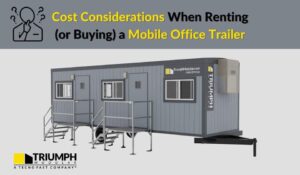Over the years, sustainability in modular construction has become a key advantage that sets it apart from traditional building methods. Modular building now plays a major role in reducing waste, cutting emissions, and reusing materials—all within a faster, cleaner, and more efficient process.
Compared to traditional construction, modular is leading the charge toward greener building. In this post, we’ll highlight three core sustainability benefits of modular construction and how Triumph Modular helps clients build with both performance and the planet in mind.
Waste Reduction in Modular Construction
It’s no secret that the construction industry creates a lot of waste. With traditional construction methods, this problem doesn’t seem to be improving, either—by 2025, waste volume is expected to reach 2.2 billion tons.
A significant portion of this waste comes from material waste. Traditional construction sites produce staggering amounts of material waste without precision in material usage or re-usage. This waste is caused by everything from material damage to building errors.
The entire premise of modular construction involves off-site building in a controlled factory environment. This allows for better inventory control, less material damage, and the reuse of components in future projects instead of discarding them as landfill waste.
Waste reduction is one of the most impactful benefits of sustainability in modular construction, especially when compared to conventional on-site building methods.
Reusability and Repurposing of Modular Buildings
Another major contributor to construction waste? Building demolitions.
Many structures are torn down once they’re no longer needed, adding to the 600 million tons of construction and demolition debris generated annually in the U.S. alone. Roughly one-quarter of the U.S. waste stream comes from construction debris.
Modular buildings are different. They’re built to be relocated, reused, or reconfigured—often multiple times throughout their lifecycle. This dramatically reduces demolition waste and the demand for new raw materials.
Our Belmont Hill School project is a great example. The school needed temporary classroom space, and we repurposed existing units from our fleet—no new materials required, and no waste created from demolition.
If deconstruction is needed, modular units generate minimal waste and can often be reused in another location. This flexibility is a core part of how modular construction supports long-term sustainability goals.
How Modular Construction Reduces Emissions
Construction sites are notorious for carbon emissions—not just from materials, but from transporting equipment, daily commutes, and on-site energy use.
Triumph Modular’s CEO, Joseph Vecchiolla, spoke at ChileMass about how traditional construction accounts for up to 38% of global greenhouse gas emissions, including those from raw material manufacturing and waste.
Modular construction dramatically cuts that number. Since building takes place off-site, there’s less need for heavy machinery at the jobsite, fewer transportation trips, and significantly less energy consumption overall.
The construction timeline is also shorter—typically by 30–50%—meaning fewer emissions from on-site crews and fewer disruptions for the surrounding environment.
Looking for More on Sustainability in Modular Construction?
As champions of sustainable building practices, Triumph Modular continues to help clients reduce their environmental impact without sacrificing performance or speed. Visit our Sustainability page to learn more about LEED, green materials, and how modular supports long-term environmental goals.




